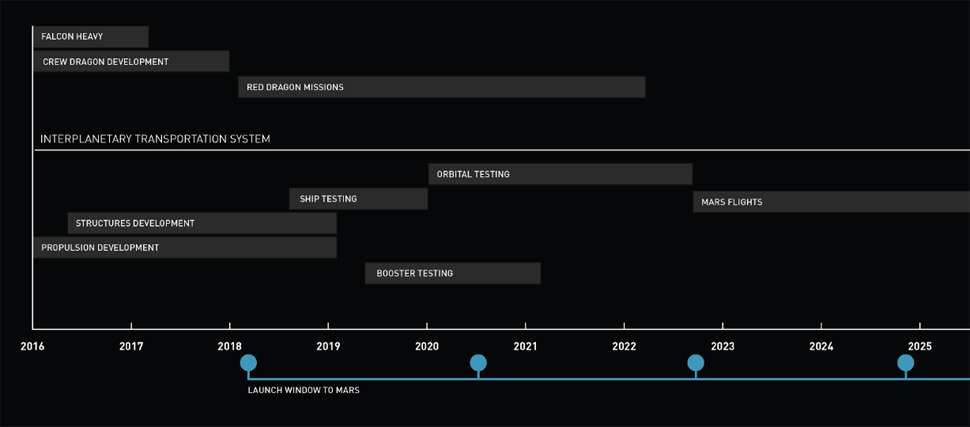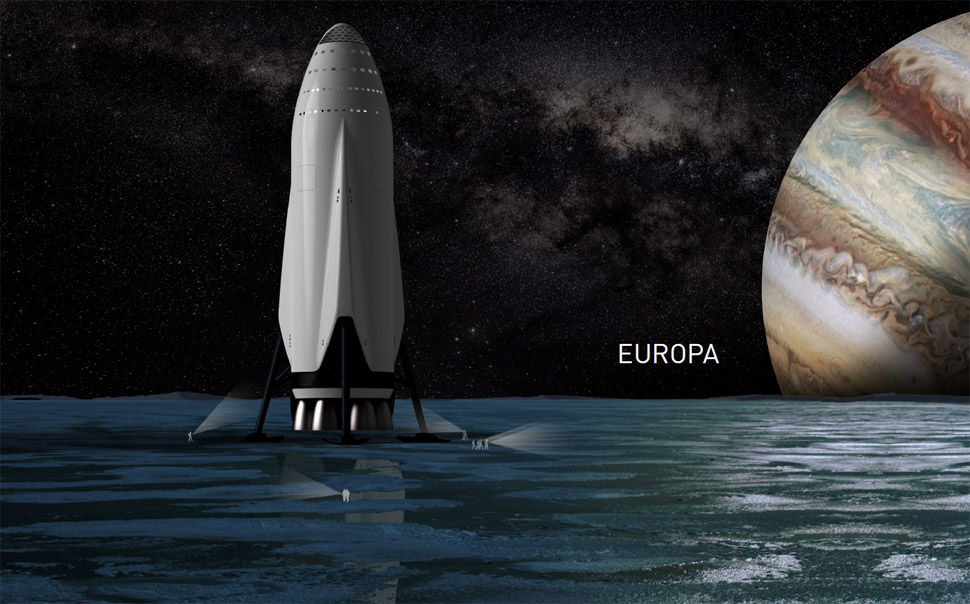
28th September 2016 SpaceX founder Elon Musk reveals plan for manned missions to Mars SpaceX founder and entrepreneur Elon Musk has revealed his plan to send humans to Mars on a new spacecraft, with the first flights beginning in the 2020s.
Yesterday, at the 67th International Astronautical Congress in Guadalajara, Mexico, Elon Musk gave a presentation in which he described his plans to send humans to Mars in the next decade. If successful, this would be achieved using the largest rocket ever designed, to launch a spacecraft capable of delivering up to 100 people into orbit. The rocket booster will be reusable, like SpaceX's existing Falcon 9 rocket, and will return to the launch pad. Another rocket launch would deliver fuel to the awaiting spacecraft, after which solar panels would be unfurled for the remaining journey to Mars. Musk claims the trip could take as little as 80 days, significantly faster than most of today's unmanned probes that typically need 180 days (six months). Upon its arrival at the Red Planet, the spacecraft would land on its feet using retro-propulsion rockets. It would be named the "Heart of Gold" after the ship commanded by Zaphod Beeblebrox in Douglas Adams' famous novel, The Hitchhiker's Guide to the Galaxy. The astronauts would then step onto the surface of a new planet, becoming the first humans to do so. For return trips to Earth, rocket fuel could be synthesised on Mars from water and CO2. As for the question of when this could all happen, Musk said he was "intentionally a bit fuzzy about this timeline". However, he wants to begin sending equipment and supplies to Mars every two years, starting with the first Red Dragon mission in 2018. The first humans could follow by the mid-2020s.
Musk is well known for his ambitious schedules when it comes to new technologies, such as electric and self-driving cars. His plans for Mars would be significantly earlier than NASA's intended missions for the 2030s. This has raised concerns regarding the financial and technical feasibility. For example, radiation could be a significant problem for the astronauts, as well as long periods without Earth's gravity, for which a great deal more research is needed to determine the impact on human health. During the presentation, he was also somewhat vague about the growing of food on Mars and the generation of energy. He said nothing about the problem of Martian dust, which not only covers solar panels, but could pose a serious risk to the astronauts' health if breathed in. In terms of the costs involved, Musk appears confident. While a trip to Mars with current technologies may cost upwards of ten billion dollars, he hopes to bring this down substantially – so that, in the not-too-distant future, a ticket to Mars could be bought for only $100,000. This would enable many thousands of people to settle on Mars within a relatively short time. In addition to funding some aspects of the Mars missions from SpaceX profits, he is seeking backers for a public-private partnership. The interplanetary division of SpaceX currently receives up to $30 million per year in funding – but this will increase substantially after the final version of the Falcon 9 rocket is rolled out. The reusability of the Mars spacecraft, in-orbit refuelling and on-site propellant production would reduce costs by "orders of magnitude".
The Interplanetary Transport System, to give its official name, is not just for Mars. In the longer term, Musk claims the system it uses could be designed for extended missions to the moons of Jupiter and even further into the Solar System. SpaceX has already begun developing the Raptor rocket engine that will power the craft. His presentation also touched on the longer-term possibility of terraforming Mars to make it habitable and Earthlike. "The thing that Mars really represents is life insurance, ensuring that the light of consciousness is not extinguished, backing up the biosphere," he said at the presentation. "It's not about everybody moving to Mars – it's about becoming multiplanetary." The full presentation including a downloadable PDF is available on the SpaceX website.
---
Comments »
|









